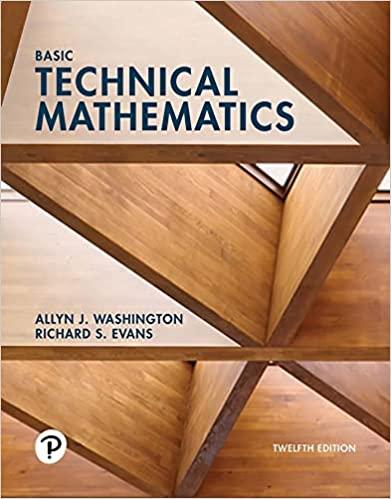Question
Financial Decision Making Pricing 1. Target costing is a A. pricing method based on variable cost B. decision-making technique for deciding whether to produce a
Financial Decision Making
Pricing
1. Target costing is a
A. pricing method based on variable cost
B. decision-making technique for deciding whether to produce a product
C. pricing method based on total cost
D. technique for costing inventory for financial statements
2. Kaizen costing
i. is a goal-setting process
ii. involves continuous improvements
iii. can create high pressure for employees
A. I
B. II
C. I and III
D. I, II, and III
3. In the U.S., predatory pricing occurs when
A. a foreign company dumps product in the U.S. at low prices
B. two organizations conspire to set prices
C. an organization prices products or services very low to drive out competition and increase market share
D. an organization sets a low price to introduce a new product
4. Price elasticity of demand
A. is a price based on total cost with a desired markup
B. indicates the sensitivity of sales to changes in price
C. is a price based on variable cost with a desired markup
D. is a calculation that relates changes in costs to changes in volume of sales
5. The death spiral is
I. setting prices very low
II. two organizations conspiring to set prices
III. a problem of prices based on average cost and declining sales
Copyright Reserved by EMERGE Management Training Center CMA / P2 / Sec. C / HW-9 2
A. I
B. III
C. I and III
D. II and III
6. Market-based pricing
A. uses a traditional markup
B. calculates price based on total cost
C. considers demand and competitors' prices
D. considers current costs and future costs in setting prices
7. In the United States, dumping is
I. selling a product at a price that is below the market price
II. not a legal problem for U.S. companies
III. prosecuted by setting tariffs
A. I and II
B. I, II, and III
C. I and III
D. II and III
8. The target costing cycle
A. focuses on reducing costs in the product and manufacturing process design phase
B. is a cost-based pricing method
C. is finished when the product is designed
D. considers cost over the life cycle of the product
9. A just-in-time manufacturing system
A. uses an assembly line for manufacturing
B. is a process that requires a lot of storage area for inventories
C. is a process in which it is difficult to maintain product quality
D. is a demand-pull system
10. Value chain analysis examines
I. business processes
II. value added and non-value added activities
III. supply chains in addition to other processes
A. I
B. I and III
C. I, II, and III
D. III
11. Cost-based pricing
A. considers price elasticity of demand
B. is uncommon
C. uses a markup percentage
D. is always based on variable cost
12. Prices that are calculated using elasticity
A. always result in profit maximization
B. is common
C. ignore customer demand
D. are based on a markup for variable cost
13. Not-for-profit pricing decisions
I. are made using the same practices as for-profit pricing decisions
II. sometimes result in different prices for different customers
III. sometimes subsidize particular groups of people
A. I and II
B. II and III
C. I, II, and III
D. III
14. The Internet and global competition
A. have not changed pricing practices
B. have increased the use of market-based pricing
C. do not provide more information about prices
D. have increased the use of cost-based pricing
15. The Internet
A. makes it more difficult to use JIT production systems
B. has not affected the relationship between manufacturers and suppliers
C. allows suppliers to monitor their customers' inventory levels and provide new inventories just as needed
D. makes it more difficult to practice target costing
16. Dyggur Traders wishes to earn a 30% return on its $100,000 investment in equipment used to produce dog toys. Based on estimated sales of 10,000 toys next year, the costs per unit would be as follows:
Variable cost $5.00
Fixed selling and administrative costs 2.00
Fixed manufacturing cost 1.00
At how much per unit should dog toys be priced for sale?
A. $11.00
B. $9.00
C. $12.00
D. None of these answers
17. Dyggur Traders wishes to earn a 20% return on its $100,000 investment in equipment used to produce dog toys. The fixed costs cannot be changed, but the company wants to set a target cost for the variable portion. Based on estimated sales of 10,000 toys next year, the price and fixed costs per unit are:
Price $9.00
Fixed selling and administrative costs 2.00
Fixed manufacturing cost 1.00
What is the target variable cost per unit?
A. $3.00
B. $2.00
C. $4.00
D. $5.00
18. (CMA) The series of activities in which customer usefulness is added to the product is the definition of
A. value chain
B. process value analysis
C. integrated manufacturing
D. activity-based costing
19. (CMA) In target costing
A. the market price of the product is taken as a given
B. only raw materials, labor, and variable overhead cannot exceed a threshold target
C. both labor and manufacturing overhead are charged directly to conversion costs
D. only raw materials cannot exceed a threshold target
Step by Step Solution
There are 3 Steps involved in it
Step: 1

Get Instant Access to Expert-Tailored Solutions
See step-by-step solutions with expert insights and AI powered tools for academic success
Step: 2

Step: 3

Ace Your Homework with AI
Get the answers you need in no time with our AI-driven, step-by-step assistance
Get Started


